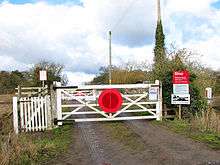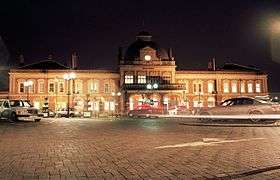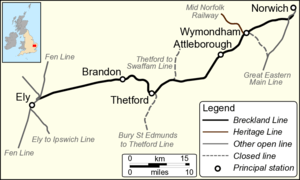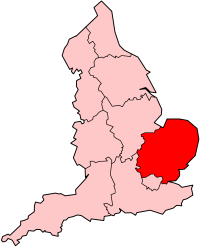Breckland line

The Breckland line is a secondary railway line in the east of England that links Cambridge in the west to Norwich in the east. The line runs through three counties: Cambridgeshire, Suffolk and Norfolk. It takes its name from the Breckland region of Norfolk, and passes through Thetford Forest.
The line is 51 miles 8 chains (82.2 km) in length from where it branches off the Fen line north of Ely to where it joins the Great Eastern Main Line south of Norwich. There are 12 stations on the line including the termini.
The line is part of the Network Rail Strategic Route 5, SRS 05.09 and part of SRS 05.05. It is classified as a secondary line, except between Cambridge and Ely, which is classified as a London and South East commuter line.[1] Passenger services on the Breckland line are operated by Greater Anglia (which manages all of the stations), CrossCountry, East Midlands Trains, and Great Northern.
History
Following the successful opening of the Yarmouth and Norwich Railway, the Norwich & Brandon Railway was incorporated in 1844 to build a line between those two places. The Eastern Counties Railway was at the same time building a route from Newport in Essex through Cambridge via Ely to Brandon. This route would be the first route between Norwich and London.
A month before opening the Yarmouth and Norwich Railway and the Norwich & Brandon Railway merged to become the Norfolk Railway.[2]
The two lines opened on the same day, 30 July 1845, although the line only opened to a temporary station at Wensum, pending the completion of the Trowse swing bridge which was achieved in December 1845. Through services from Shoreditch (later known as Bishopsgate) to Norwich Thorpe station started on 15 December 1845.[3][4]
Although it was expected that locomotive changes would take place between the two companies at Brandon where an engine house had been built, the Norfolk Railway in fact operated trains to Ely. The ECR and its rival the Eastern Union Railway (EUR) were both sizing up the NR to acquire and expand their railway empire. The ECR trumped the EUR by taking over the NR, and became responsible for operating the services from 8 May 1848.[5]
By the 1860s the railways in East Anglia were in financial trouble, and most were leased to the Eastern Counties Railway, which wished to amalgamate formally but could not obtain government agreement for this until an Act of Parliament on 7 August 1862, when the Great Eastern Railway (GER) was formed by the amalgamation.[6]
The system settled down for the next six decades, apart from the disruption of the First World War. The difficult economic circumstances after the war led the Government to pass the Railways Act 1921 which led to the creation of the Big Four railway companies. The GER amalgamated with other railways to create the London and North Eastern Railway (LNER) on 1 January 1923.
Accidents and incidents
- Accidents at Norwich Thorpe and Trowse, and those at Ely, Waterbeach, Cambridge North and Cambridge are not covered in this section.
- On 9 January 1847, two ballastmen were killed when the wagon they were travelling on broke up near Lakenheath.[7]
- On 5 January 1854, two trains were in collision near Thetford.[8]
- On 1 July 1865, a passenger train was derailed as it passed under the viaduct carrying the Great Eastern Main Line at Lakenham, Norfolk. Three people sustained minor injuries.[9]
- On 12 October 1870, a mail train collided with a freight train at Brandon.[10]
- On 9 January 1875, a mail train ran into the rear of a freight train at Thetford. At least five people were injured.[11]
- On 1 June 1875, a cattle train derailed at Harling Road.[12]
- On 13 January 1879, a freight train ran into the rear of a passenger train at Wymondham. Several passengers were injured.[13]
- On 19 January 1880, a freight train ran into the rear of another at Brandon.[14]
- On 6 July 1881, a light engine was in collision with a passenger train at Wymondham North Junction. Thirteen people were injured.[15]
- On 7 April 1906, a passenger train was derailed at Shippea Hill due to excessive speed. Eight passengers were injured, two seriously.[16]
- On 4 June 1926, a motor bus crashed through the parapet of an overbridge at Thetford and landed on top of a stationary train.[17]
- On 27 October 1926, a freight train was in collision with a lorry at Roudham Heath, Norfolk due to errors by the crossing keeper. The lorry driver was killed.[18]
- On 3 December 1976, a passenger train collided with a lorry on an unmanned level crossing at Shippea Hill. The train driver was killed and eight of his passengers were injured.[19]
- On 12 September 2006, Class 170 diesel multiple unit 170 206 was derailed as it crossed the level crossing at Croxton, Norfolk. A panel that formed part of the level crossing had become dislodged and fouled both railway and road.[20]

- On 10 April 2016, Class 170 unit 170 204 collided with an agricultural tractor on a private level crossing at Roudham, Norfolk. The tractor driver was seriously injured, the train driver and six passengers sustained minor injuries.[21][22] A preliminary investigation revealed that the tractor driver had obtained permission to cross the line.[23]
Infrastructure
The line is double-track throughout but is only electrified between Cambridge and Ely, and also between Norwich and Trowse Junction, at 25 kV AC. It has a loading gauge of W8, except for the section connecting the Ipswich–Ely line to the Ely–Peterborough line, which is W10. The line speed ranges between 40 and 90 mph.[1]
Until 2012 the line retained its historic characteristics, with well preserved stations, semaphore signalling and, until spring 2009, lineside telegraph poles, along with sections of jointed rail on wooden sleepers. However, the two-stage Ely–Norwich re-signalling programme in August and December 2012 involved the closure of the nine local mechanical signal boxes and removal of the seven sets of manually-operated wooden gates at level crossings. The Cambridge signal box now controls the modern electronic interlockings which operate the lightweight LED signals, while the level crossings have been fully automated with barriers and warning lights.
Route
The places served by the route are listed below, with Ordnance Survey grid references for the stations:
| Place | Station and grid reference |
| Norwich | Norwich: TG239083 |
| Wymondham | Wymondham: TG114009 |
| Spooner Row | Spooner Row: TM094974 |
| Attleborough | Attleborough: TM051950 |
| Eccles and Quidenham | Eccles Road: TM018900 |
| East Harling | Harling Road: TL977879 |
| Thetford | Thetford: TL867836 |
| Brandon | Brandon: TL784872 |
| Lakenheath | Lakenheath: TL723863 |
| Burnt Fen area | Shippea Hill: TL641841 |
| Ely | Ely: TL543793 |
| Cambridge | Cambridge: TL461572 |
Prickwillow station, between Ely and Shippea Hill stations, closed in 1850.
Services
Some of the stations on the Breckland line see just one stopping train in each direction per day, mostly in the Norwich direction in the morning and in the Cambridge direction in the afternoon or evening. Three stations on the line are request stops only: Spooner Row, Lakenheath and Shippea Hill.
Passenger services are operated by several companies:
- Abellio Greater Anglia operates a typically hourly service between Cambridge and Norwich, using Class 170 diesel multiple units.
- East Midlands Trains operates various services between Ely and Norwich, as part of its Liverpool–Norwich route, usually using Class 158 diesel units, although Class 153 and Class 156 units may sometimes be used.
- CrossCountry operates various services between Cambridge and Ely as part of its Birmingham–Stansted Airport route, usually using Class 170 diesel units.
- Thameslink and Great Northern operates various services between Cambridge and Ely as part of the Fen line route to King's Lynn, usually using Class 365 electrical multiple units.
References
- 1 2 3 "Route 5 – West Anglia" (PDF). Network Rail. Retrieved 2009-05-22.
- ↑ Allen, Cecil J. (1975). Great Eastern Railway (3rd ed.). Shepparton, UK: Ian Allan Limited. p. 24. ISBN 0-7110-0659-8.
- ↑ "Station history". Wymondham Station. Archived from the original on 2006-05-11. Retrieved 2009-05-04.
- ↑ Allen, Cecil J. (1975). Great Eastern Railway (3rd ed.). Shepparton, UK: Ian Allan Limited. p. 234. ISBN 0-7110-0659-8.
- ↑ Allen, Cecil J. (1975). Great Eastern Railway (3rd ed.). Shepparton, UK: Ian Allan Limited. p. 30. ISBN 0-7110-0659-8.
- ↑ Vaughan, Adrian (1997). Railwaymen, Politics and Money. London: John Murray. pp. 134, 135. ISBN 0 7195 5150 1.
- ↑ "Fatal Accidents on the Eastern Counties Railway". The Morning Chronicle (24093). 12 January 1847. p. 3.
- ↑ Capt. Douglas Galton / Board of Trade (2 March 1854). "Eastern Counties Railway" (PDF). Railways Archive. Retrieved 10 April 2016.
- ↑ Colonel W Yolland / Board of Trade (31 July 1865). "Great Eastern Railway" (PDF). Railways Archive. Retrieved 10 April 2016.
- ↑ "News of the Day". Birmingham Daily Post (3819). 14 October 1870. p. 4.
- ↑ "Railway Accidents". The Glasgow Herald (10933). p. 5.
- ↑ "Railway Accidents". The Bradford Observer (3877). 2 June 1875. p. 3.
- ↑ "Wymondham". The Ipswich Journal (7702). 18 January 1879. p. 5.
- ↑ "General News". Jackson's Oxford Journal (6619). 24 January 1880. p. 7.
- ↑ "Accident on the Great Eastern Railway". Liverpool Mercury (10449). 7 July 1881. p. 5.
- ↑ Lt. Col. P G von Donop / Board of Trade (7 May 1906). "Great Eastern Railway" (PDF). Railways Archive. Retrieved 10 April 2016.
- ↑ "Fall of an Omnibus onto a Railway". The Times (44291). London. 7 June 1926. col C, p. 16.
- ↑ Lt. Col A H Mount / Board of Trade (7 January 1927). "London and North Eastern Railway" (PDF). Retrieved 10 April 2016.
- ↑ "Report on the Accident that occurred on 3rd December 1976 at Chivers Occupation Level Crossing (No. 1) between Lakenheath and Shippea Hill in the Eastern Region British Railways". The Railways Archive. 4 February 2014. Retrieved 9 December 2016.
- ↑ "Derailment of a train at Croxton Level Crossing 2 September 2006" (PDF). Rail Accidents Investigation Board. May 2008. Retrieved 10 April 2016.
- ↑ Bishop, Donna-Louise (10 April 2016). "Tractor driver suffers serious injuries following collision between train and tractor at Roudham, near Thetford". Eastern Daily Press. Archant Media Ltd.
- ↑ "Train carrying 135 passengers crashes at level crossing". ITV News Anglia. Retrieved 10 April 2016.
- ↑ "Collision near Thetford". Rail Accidents Investigation Branch. Retrieved 22 April 2016.


